After thousands of shots taken with a whale lens, and after viewing millions of images on the Internet, shot with high-aperture optics, sometimes you just want to try something new and fast. After the 'boring' stock lens that usually comes with a camera, the tiny Nikon 50mm 1: 1.8D AF Nikkor (MKIII) is a great addition.
Note that I call this the MKIII because it is the third version of the Nikon Nikkor AF 50mm F1.8 class lens. On the net it is usually called simply - Nikon 50mm F / 1.8D AF, any representation of letters is allowed :).
All Nikon 50 / 1.8 Autofocus Lenses
- Nikon 50mm 1: 1.8 AF Nikkor (first version, MKI) - the lens was produced only in Japan from 1986 to 1990. It is easy to distinguish by a window with a focusing distance and a narrow plastic focus ring. There are two subversions that are no different:
- MKI first subversion. Weighing 210 grams. It is easy to distinguish by the screw under the inscription '1: 1.8'. From September 1986 to March 1987. Serial numbers start at 2
- MKI second version. Weighing 165 grams. It is easy to distinguish by the absence of a screw under the inscription '1: 1.8'. From 1987 to 1990. Serial numbers start at 3.
- Nikon 50mm 1: 1.8 AF Nikkor (second version, MKII, also known as the 'N', or the 'NEW' version) - the lens was produced in Japan and China. The MK II version was produced from 1990 to 2001. There are three subversions that are no different:
- Nikon 50mm 1: 1.8D AF Nikkor (third version, MKIIIbetter known as 'D'-version) - the lens is available from 2002 to this day. All lenses are made in China.
- Nikon AF-S Nikkor 50mm 1: 1.8G SWM Aspherical (fourth version, MKIVbetter known as '1.8 G'-version or '1.8 AF-S' version) - the lens has been produced since 2011, all lenses are made in China.
- Nikon AF-S Nikkor 50mm 1: 1.8G SWM Aspherical Special Edition (fifth version, MKVbetter known as version 'Special Edition' or 'SE' or version for the camera with a retro design of the case Nikon Df) - the lens has been available since the fall of 2013. All lenses are made in China.
- Nikon Nikkor Z 50mm 1: 1.8 S, from summer 2018, lens for mirrorless cameras with Nikon Z mount... Diagram of 12 elements in 9 groups, 2 ED, 2 ASP.
Details on the lineup of fifty dollars from Nikon can be found in my article 'All Nikon autofocus fifty dollars'.
If you want to feel what aperture maneuver for real - Nikon 50mm 1: 1.8D AF Nikkor will help you very quickly. In this review, I will try to cover the specifics of using the Nikon 50mm 1: 1.8D AF Nikkor in real life.
As they say, the wizard casts a magic wand, and the sorceress uses a magic hole - it is the 'hole' (relative aperture of the lens) that attracts most of all in this lens, the maximum value of which is 1: 1.8. A lens with such a focal length and such aperture suggests that when focusing at close distances it will be easy to get 'bokeh effect'and blur the foreground and background.
Main technical characteristics of Nikon 50mm 1: 1.8D AF Nikkor:
| Review Instance Name | Nikon 50mm 1: 1.8D AF Nikkor 2860907 |
| Basic properties |
|
| Front Filter Diameter | 52 mm, plastic thread for filters |
| Body materials | Focusing ring plastic, rubberized on the outside. The outer case is made of plastic. Metal mount. The diaphragm control ring is plastic. |
| Focal length | 50 mm, EGF for Nikon DX cameras is 75 mm, EGF for Nikon CX cameras is 135 mm |
| Diagonal viewing angles | 46 ° for FX cameras, 31 ° for DX cameras |
| Zoom ratio | 1 X (this is a fixed lens without the ability to change the focal length) |
| Designed by | for film and digital cameras Nikon FX / Nikon DX. When the lens exited the Nikon digital cameras, only the cropped Nikon D1s were present, D1h, D1x и D100. |
| Number of aperture blades | 7 non-rounded petals |
| Tags | marking on the focus ring with the focusing distance in meters and feet, depth of field scale for F / 22 and F / 11. Label for working in the infrared spectrum (white dot near the depth of field scale). Ring with aperture values, there are marks for F / 1.8, 2.8, 4, 5.6, 8, 11, 16, 22. |
| Diaphragm | from f / 1.8 to f / 22. The lens has an aperture ring (Non-G - lens type) |
| MDF (minimum focusing distance) | 0.45 m, maximum magnification ratio 1: 6.6 |
| The weight | 155 g |
| Optical design | 6 elements in 5 groups. The lens does not use special optical elements.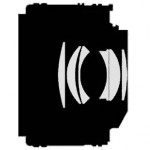 The image with the optical circuit is clickable. Lens version MKI и MKII use the same optical design. The image with the optical circuit is clickable. Lens version MKI и MKII use the same optical design. |
| Lens hood | Rubber hood Nikon HR-2. The lens hood is not included in the scope of delivery; the lens hood is screwed into the thread under the filters. |
| Transportation | Using the CL-S1 or CL-0715 soft case or using the CL-30S case. A case or case is not supplied and must be purchased separately. During transport, use standard rear (e.g. LF-1 or LF-4) and front (e.g. LC-52) covers. Usually sold with a white plastic translucent back cover. and black front. The lens is sold in a classic Nikon golden box (there are several modifications of the box design). |
| Period | from February 2002 to the present |
| Manufacturer country | Made in China (all MKIII lenses are made in China) |
| Instructions | See |
| 3D view | See |
| Price |
Nikon 50mm 1: 1.8D AF Nikkor (MKIII) - very lightweight lens. It has the smallest weight in its class. Due to its very small size and low weight, you can always take it with you. And finding a 52 mm filter is as easy as shelling pears. I really love hikesand every extra 100 grams of weight is a serious challenge, so instead of some heavy zoom lens I often use the Nikon 50mm 1: 1.8D AF Nikkor.
Nikon 50mm 1: 1.8D AF Nikkor smallest autofocus lens from Nikon that I have ever seen. There is a joke that it is in the pocket of every photographer. Just a joke, but I often keep Nikon 50mm 1: 1.8D AF Nikkor in my case, it takes up little space and I don't mind losing it.
Nikon 50mm 1: 1.8D AF Nikkor - one of the cheapest (if not the cheapest) fast fixed lens from Nikon. It is hard to find something cheaper. The lens will allow you to get the necessary experience for a little money when working with high-aperture optics, including fixed lenses. I almost always recommend the Nikon 50mm F / 1.8D AF as the first optional lens.
Nikon 50mm F / 1.8D AF can open the aperture up to f / 1.8. For example, an aperture ratio of 1: 1.8 is about 10 times morethan 1: 5.6. For example, class lenses 18-55/3.5-5.6 with the same focal length have 1: 5.6. F / 1.8 will allow you to shoot at low ISOs in low light conditions, use short excerpts when shooting handheld, and will also allow better control GRIP.
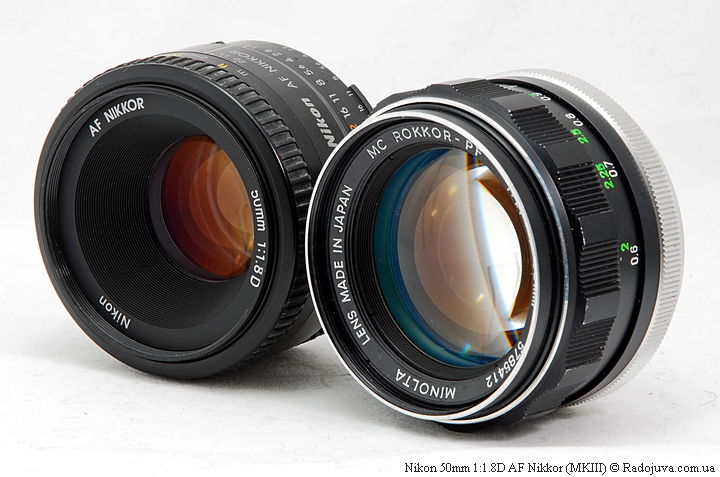
Nikon 50mm 1: 1.8D AF Nikkor (MKIII) and Minolta MC Rokkor-PF 1: 1.4 f = 58mm
Nikon 50mm F / 1.8D AF is very affordable lens, it is easy to find it in any store in any city. A huge number of copies of this model were released. Nikon 50mm f / 1.8D AF lenses are available with 2002 to this day.
It's a shame, but all Nikon 50mm 1: 1.8D AF Nikkor (MKIII) lenses are made in China. And here are his predecessors Nikon AF Nikkor 50mm 1: 1.8 (MK I) и Nikon AF Nikkor 50mm 1: 1.8 (MK II) produced in Japan.
The lens has fast auto focus system - on my camera, the lens focuses from 45 cm to infinity and back in one second. The most interesting thing is that his motorized brother Nikon AF-S Nikkor 50mm 1: 1.8G SWM Aspherical has exactly the same focusing speed. I tested both lenses together. Plus, the Nikon 50mm f / 1.8D AF focuses even faster than the flagship half a ruble - Nikon AF-S Nikkor 50mm 1: 1.4G.
Attention: the fact that the small Nikon 50mm 1: 1.8D AF has no built-in focus motor has nothing to do with focusing speed.
It's important: auto focus with this lens is available only when using him on cameras with built-in motor focusing.
Exact list Nikon DSLR cameras with a built-in focus motor, on which this lens will focus automatically:
- D1, D1h, D1x, D2x, D2xs, D2h, D2hs
- D3, D3x, D3s, D4, D4s, D5, D6
- Df
- D50, D70, D70s, D80, D90
- D7000, D7100, D7200,D7500
- D100, D200, D300, D300s,D500
- D600, D610, D750, D780
- D700, D800,D800E, D810, D810a, D850
- Fujifilm FinePix S1 Pro, S2 Pro, S3 ProS3 Pro UVIR, S5 ProIS Pro
- Kodak DCS PRO 14n, DCS Pro SLR/n
Exact list Nikon DSLR cameras without a built-in focus motor, on which this lens will not focus automatically:
Only auto focus and sound confirmation of focus will not work with these cameras, all other important functions, such as automatic exposure metering and automatic iris control, will work well.
You will find a lot of useful information on the types of cameras and lenses Nikon here.
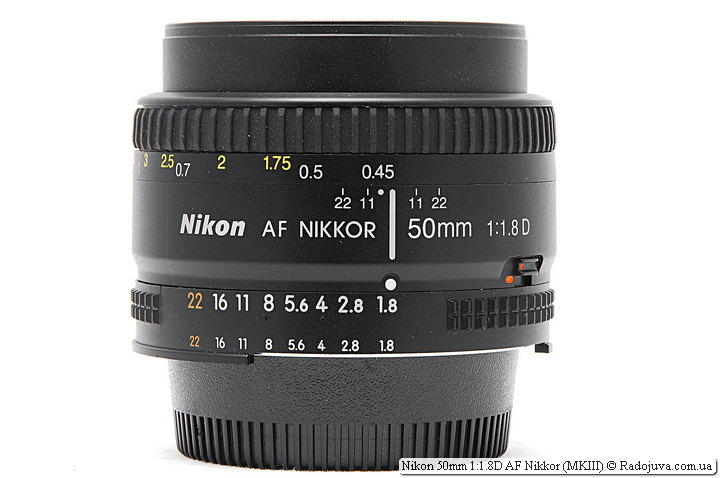
Nikon 50mm 1: 1.8D AF Nikkor (MKIII) while focusing at the minimum focusing distance (trunk extended as far as possible)
Attention: the lens has a manual aperture ring. To be able to control the value aperture from camera or for automatic installation aperture on modern central control valves, you need to turn the control ring to the F / 22 value (the value is colored in orange) and fix it with a special lever, which is located to the right of the marks aperture. If this is not done, then on a number of cameras, the display will display an error - 'fEE' (ring is not installed aperture) Some cameras having diaphragm rheostatallow you to control the diaphragm with this ring aperturebut only in metering modes exposure 'M' and 'A'. You can read more about this issue in the section on Non-G Lenses. Ring aperture rotates with clicks, the values F / 1.8, 2.8, 4, 5.6, 8, 11, 16, 22 are plotted on it, it is impossible to establish an intermediate value between pairs of numbers. This ring is useful, for example, for reverse macro shot.
Nikon 50mm F / 1.8D AF has focus distance scale. The scale is available in meters and feet, it is very nice and useful. For example, you don’t need to think in which direction the focus ring is rotated, just look at the lens for this. For example, a whale lens Nikon 18-55mm 1: 3.5-5.6GII VR II AF-S DX Nikkor It has neither a focus distance scale, nor a depth of field scale, nor an aperture control ring.
Nikon 50mm F / 1.8D AF has the ability to work on full frame the camera and is a Nikon FX type lens. On the Nikon DX cameras his EGF will be 75 mm. More details about FR and EGF in the section about 'crop factor'.
Nikon 50mm F / 1.8D AF has bayonet mount metal back... This is great news as many people think that the Nikon 50mm f / 1.8D AF is very lightweight and is made out of plastic.
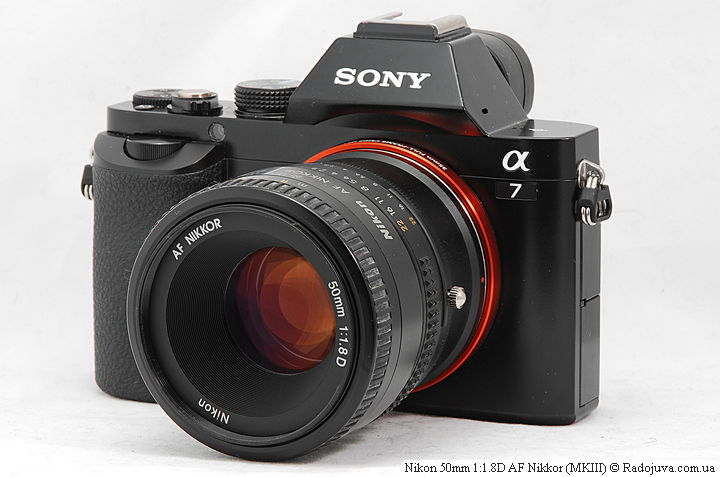
Nikon 50mm 1: 1.8D AF on camera Sony a7. The aperture control ring allows you to use the lens on any camera through the appropriate adapter.
When focusing front lens does not rotate. This allows you to easily use different filters and not worry about their shifts when focusing. The focus ring is rubberized and rotates 120 degrees, but in order to slightly shift the focus ring, you need to 'tear it off'. At the same time, smooth focusing is lost, since after such a “jerk” the ring flies over the desired value. The effort is not so great, but when working in macro mode, where, due to the very small depth of field, each degree of rotation plays a huge role, this “slightly twitchy” method of focusing greatly inflates the nerves during manual focusing. There is a similar effect on many other lenses, most pronounced on the 'dark' Nikon ED AF-S Nikkor 24-120mm 1: 3.5-5.6G SWM VR IF Aspherical. Nikon 50mm 1: 1.8D AF Nikkor users who always shoot with autofocus will most likely never notice the effect described above. Also, it is worth noting that the previous version of this lens, namely Nikon AF Nikkor 50mm 1: 1.8 (MKII, MIJ version)had no such problem.
Lens disadvantages:
- When using Nikon 50mm F / 1.8D AF lens on open apertures it is very difficult to achieve a sharp image... True, I noticed such a feature that sharpness disappears at apertures from F / 1.8 to F / 2.8. At f / 2.8-f / 8.0 aperture, the lens becomes very sharp.
- Nikon 50mm f / 1.8D AF pretty makes a lot of noise during auto focus. When you miss focusing, the lens buzzes annoyingly, and the camera motor scares small insects and nervous people, betraying the photographer in a quiet environment. Noisy autofocus has a very negative effect when shooting video.
- Nikon 50mm F / 1.8D AF does not have a built-in focus motor. As mentioned at the beginning of the article, it can be used with autofocus only on cameras with a focusing motor.
- There is no hood included with the Nikon 50mm F / 1.8D AF. The hood is attached by screwing it into the filter thread.
- When focusing, the entire lens block moves, while the 'lens trunk' extends forward.
- On the lens no focus mode switch, the transition to manual focus and back is carried out by means of a switch on the camera, which is located near the camera mount.
- The lens has a total of 7 non-rounded aperture blades that create 'nuts' in the out-of-focus area.
- The Nikon 50mm F / 1.8D AF is well built, but over time, a slight play in the focusing ring appears. If you shake the lens slightly, you can hear the tapping of the focusing ring. This is not a problem, just a small specific flaw.
With all the pros and cons Nikon 50mm 1: 1.8D AF Nikkor - an indispensable lens in all situations. For me personally, it is inconvenient in that the auto focus on my camera does not work Nikon D40which I often use. On the open aperture, the sharpness zone is very small and it’s very difficult to manually enter it.
All photos in the gallery below are shot on a Nikkor 50mm 1.8D AF and full-frame camera. Nikon D700 FX, photo without processing, only the size is reduced to 3MP and data from EXIF.
The gallery below shows photos from Nikon 50mm 1: 1.8 AF Nikkor NJ (NIKON JAPAN, MKII) without treatment:
Jpeg source photos download from this link (1.09 Gb). The archive is 453 photosfilmed in 6 months on Nikon D70. Oddly enough, but I enjoy working with this old and very cheap Nikon D70 both old and very cheap Nikon 50 / 1.8... The camera cost me $ 50, the lens - $ 90. On a 6 MP CCD sensor, even at F / 1.8, acceptable sharpness is obtained. I did not regret the shutter and filmed as much as my soul wanted. Photos from this collection are used by me in an article about choosing a Nikon DSLR. Examples of photos with processing can be found in my gallery here. You can see more examples of photos on Nikon 50mm 1: 1.8D AF Nikkor (MKIII) in the review Nikon D300 и Fujifilm FinePix S5 Pro и S1 Pro.
And also this link You can see my gallery of pictures obtained with the help of an old man Nikon D100 (Nikon's first digital SLR camera in a classic case) paired Nikon AF Nikkor 50mm 1: 1.8 (MKII, MADE IN CHINA).
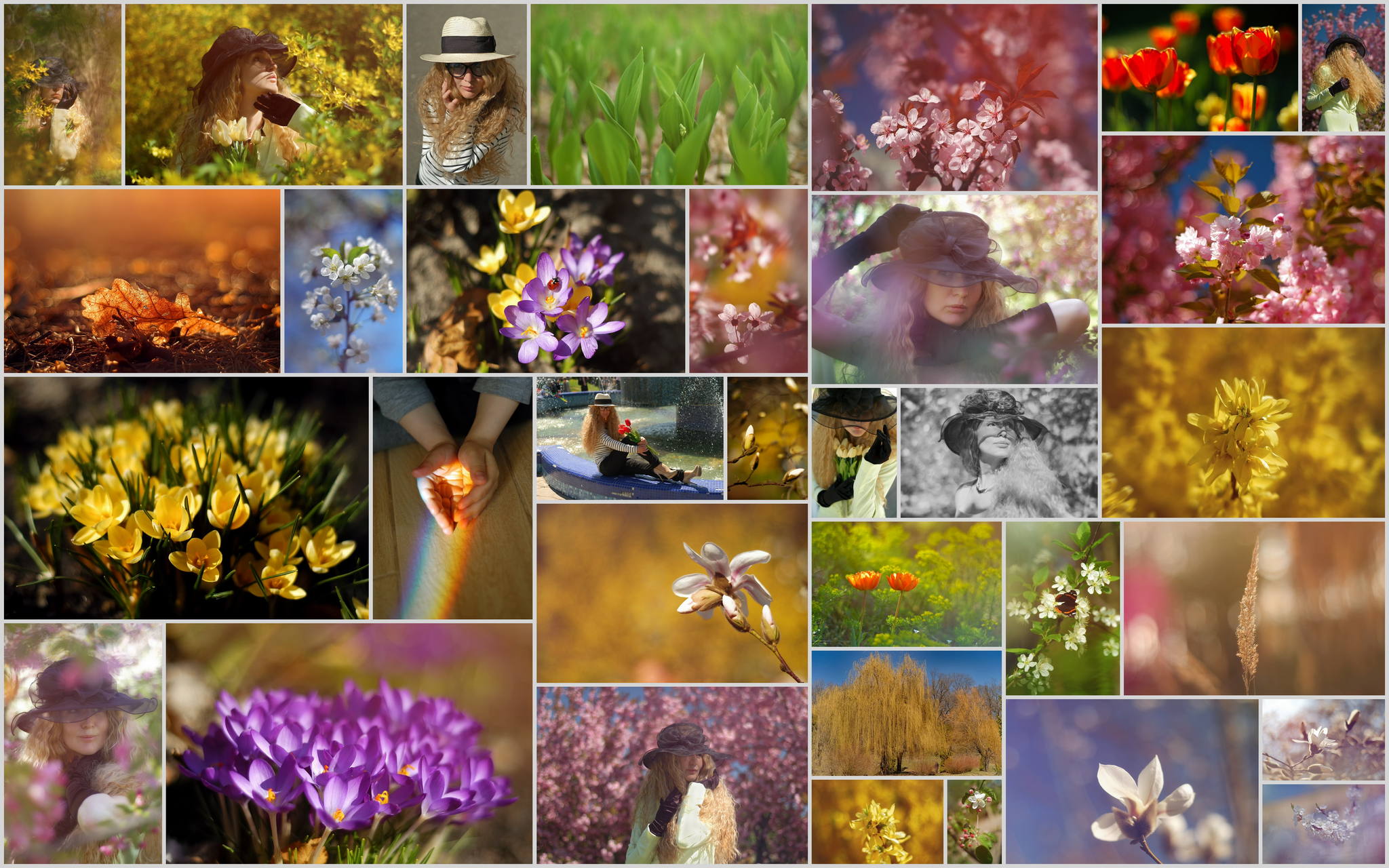
All pictures were taken with Nikon AF Nikkor 50mm 1: 1.8, MKII version, MIC (MADE IN CHINA) и Nikon D100. Enlarge Image or go to the gallery with large format photographs.
Video review
Short video review Nikon 50mm 1: 1.8 AF Nikkor NJ (NIKON JAPAN, MKII) you can see on my channel here.
Fifties Recommendations for Nikon Cameras
A list of all-all Nikon Nikkor autofocus lenses, as well as my recommendations for choosing the best option for specific tasks, can be found in the 'All Nikon autofocus fifty dollars'.
My experience
I really love the Nikon 50mm 1: 1.8D AF Nikkor. This is my first autofocus fast aperture lens, which I used in a wide range of photo tasks and spent a huge number of shoots with it.
As a result, Nikon 50mm 1: 1.8D AF Nikkor is:
- The easiest original full frame fixed focus lens with auto focus
- The cheapest Original fast prime lens with auto focus
- Most affordable Original fast prime lens with fixed focal length and auto focus in the secondary market. Countless instances of it have been released.
- The most compact original fixed focus lens with auto focus
- One of the fastest original autofocus lenses for FX and DX cameras (brighter only ten lenses with f / 1.4Unfortunately Nikon does not release aperture optics for FX cameras with support for autofocus)
- One of the best price / quality lenses
A huge number of lenses from Nikon (hundreds of models) passed through my hands. In my personal opinion, the Nikon 50mm 1: 1.8D AF Nikkor is one of the best lenses of all time from Nikon.
Lens prices
Real prices for the lens in popular online stores can see here, or in the price block below:
Also, this lens can be found on:
- Look at Power outlet
- Look in Connected
- Look at E-Catalog
- Look at Magazilla
- Look at M.Video
- Look at Ozone
- Look at Nadavi
- Euroset
- On the AliExpress
Comments on this post do not require registration. Anyone can leave a comment. Many different photographic equipment can be found on AliExpress.
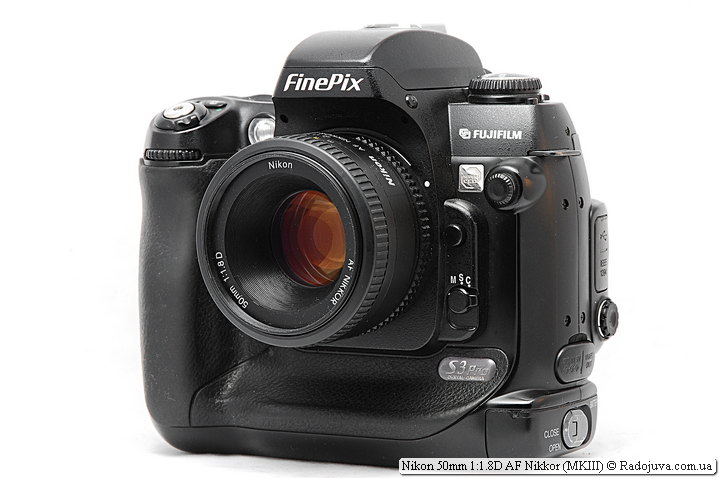
Nikon 50mm 1: 1.8D AF Nikkor on camera Fujifilm FinePix S3 Pro
Results:
Nikon 50mm 1: 1.8D AF Nikkor (MKIII) - great lens for the money... Due to its compactness and lightness, the Nikon 50mm 1: 1.8D AF Nikkor (MKIII) can always be taken with you. It can produce very sharp images with slightly rough bokeh. On DX cameras it can be used as a conventional portrait lens. The lens' only serious drawback is the lack of sharpness at apertures from F / 1.8 to F / 2.8.
UPDATE: in 2016, a Chinese lens appeared, based on the Nikon 50mm 1: 1.8D AF Nikkor optical circuit (optically no worse) and with an integrated focus motor. See YONGNUO 50mm 1: 1.8 review (YN50mm F1.8N).
Material prepared Arkady Shapoval. Training/Consultations | Youtube | Facebook | Instagram | Twitter | Telegram

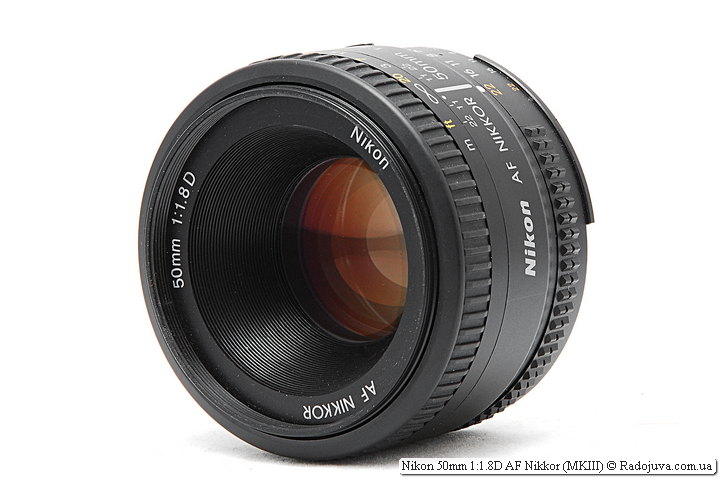
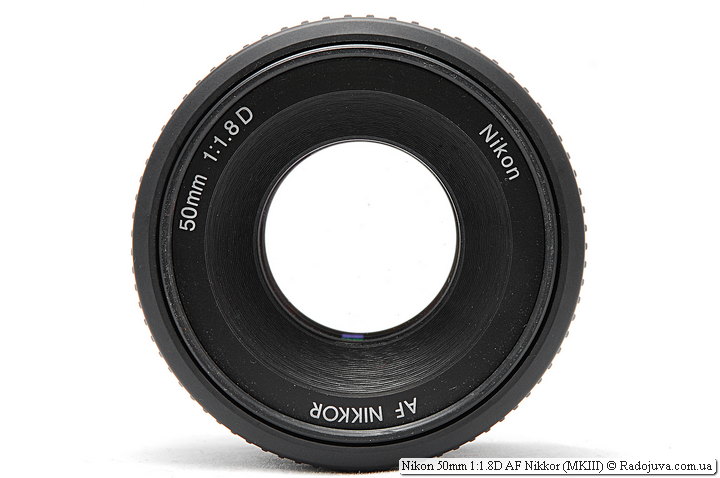
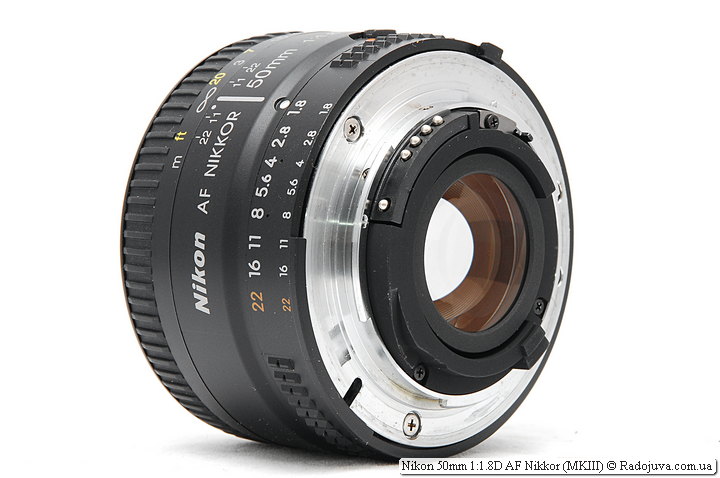
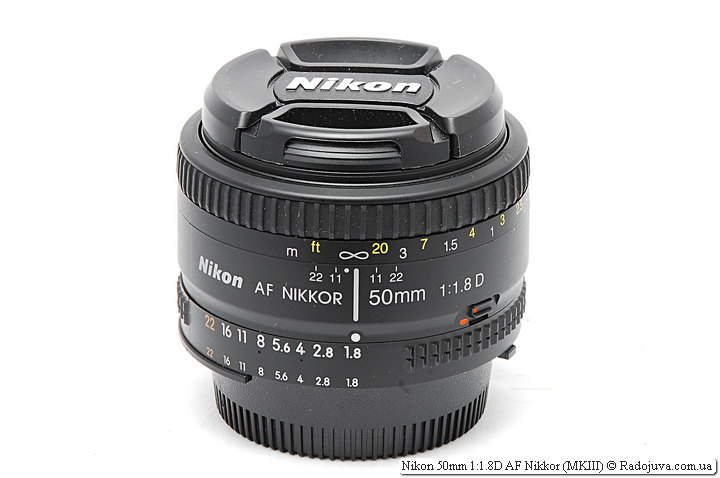
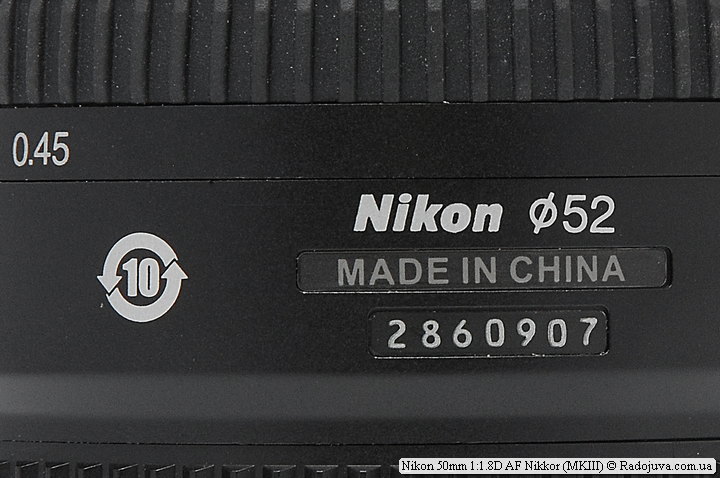

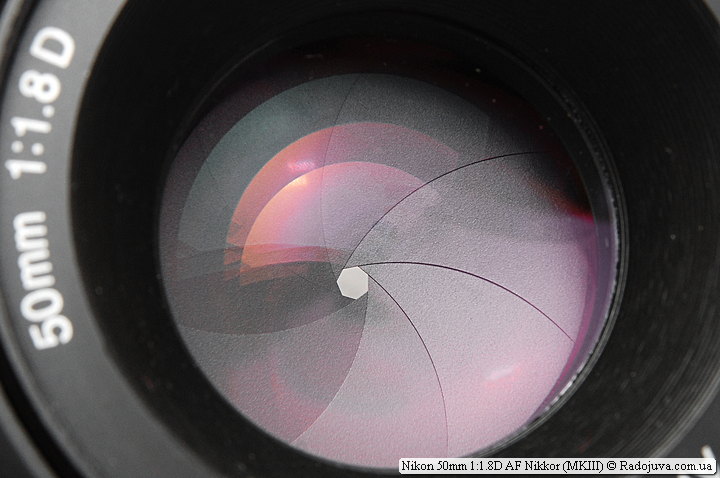

























































































































Duzha 1,8 miles. Robot diaphragm 2,8.
In the irrelevant grievances! For your penny, cinnamon and good fair!
The day before yesterday I bought myself)
To work with children in the interior is a must have.
And I don’t know why you have it differently, but I have a hood and a suede case in the kit.
Are you sure you have version D and not G? My copy came in a standard Nikon box with all the documents, but without a case and a hood.
Hello. If you can help, please explain to me ..
I bought 50 mm 1.8d on the Nikon 90d ..
With an open aperture, the background is very blurry.
But not even in this matter. When I zoom in (I twist its wheel in the lens itself), the blurry background even with the aperture open or closed. What to do ? ((And the same garbage when I leave the object in literally 2-3 steps.
Here you can take sharp pictures, even if the girl is completely standing, but everything is blurry with me .. I can’t understand why (
Good afternoon. Most likely the matter is in practice. Use auto focus as an option.
And there is a hood on it ???? 8- (~)
Just an excellent objektivchik, as it is written after "Whale" is simply lovely, the pictures are good.
Arkady, and with manual focus, the signal on the d40 will beep?
No. Will not. In this regard, any manual with Dandelion Lushnikov wins in comparison with native AF lenses.
Explain the teapot on nikon d3100 only manual mode M will work?
No, other modes will work, but only with manual focus.
Arkady, what is the difference between version G and D?
Here is an article on this topic https://radojuva.com.ua/2012/03/nikon-lenses/ Briefly, in the D version there is no autofocus motor, in the G version there is a focus motor, the differences also relate to the optical design, different diameters of the front filter, etc.
why are you confusing us? you described above that for D, on the contrary, with a motor, and for G - without a motor. Where is the truth?
I wonder where I wrote this?
Everything is very simple
Nikon 50mm f / 1.8D AF Nikkor, Nikon 50mm f / 1.8 AF Nikkor and Nikon 50mm f / 1.4D AF NIKKOR do not have a focus motor and will not allow auto focus on younger cameras, and Nikon 50mm f / 1.8G AF-S Nikkor, Nikon 50mm f / 1.4G AF-S Nikkor have SWM and will focus on any Nikon Central Control Center.
Thank you, Arkady, for your reviews they really help newcomers like me !!!!!!
I bought 50 / 1,8D in 2009 in addition to 18-70, I use it on the D 80,
sheer delight - although the 18-70 is not the worst of Nikon's lenses, I like fifty dollars more in terms of color and picture.
I’ve rarely rented it recently.
Thanks for the reviews, very interesting.
Arkady, tell me. I'm going to take the first DSLR - D80 and a lens. Just what?
I read about 50mm - very good! They say after the whale does not compare. Duck, you think it's worth taking 50mm?
Purpose of shooting: we are going to go with friends to Europe, I want to take a picture of everyone and everything) As a keepsake. I want good pictures.
With 50mm do I get it?
Thank you.
Good photos will turn out if you make an effort. I recommend a universal zoom for travel that allows you to use a wide angle. For example, to remove a group of friends with 5 people in full growth against the backdrop of some European attractions, you will need to move away by about 5 meters.
Please tell me what you think on the d3100 what picture quality will be with a Nikkor 50 mm Series E 1.8 Ais lens
Same as on other cropped cameras. The lens is not bad.
Will it be difficult to focus manually on the nikon D3100?
Set the autofocus on your whale lens to manual mode, unscrew the zoom by 55mm and try to take pictures with manual focus.
I tried, on the whale there is a smaller angle of rotation, it is very difficult to direct. After it, af 50d is much more convenient, although it can’t be compared with helios
Is it possible to put a hood on it ??? and which is better for half a petal or ordinary?
yes, you can. A lens hood that is screwed into the filter thread. I Use Normal. The tulip lens hood is mainly used for zooming where the focal length changes.
by the way, what kind of hood (its model) is it supposed to buy this half if you buy it ?? thanks in advance for such "teapot" questions
For fifty dollars, Nikon has a rubber hood RH-2 with the possibility of "compression" to save space in the wardrobe trunk.
for the DX camera, what about the opportunity to lose money on 50 mm, who will already be 75 mm, is it possible that they will not expand in front of him?
EGF will be 75, it will be difficult in the room.
to go for dx-cameras of fiksa 50 mm in nikona nemaє? hiba brothers 35mm f / 2D AF, like a 55mm or Nikkor 40mm f / 2.8G AF-S DX Micro. ale the stench, for the sake of my mind, I won’t be militarily like that, as if it was 50 mm, why would I have mercy? will you please, what kind of vikhid? in sigmy I am amazed at 50 mm just for single-frame ...
Nobody makes croaked fifty. Take any regular 50mm 1.8 or 1.4. If you only need a viewing angle, then there is a wonderful cropped 35mm F1.8G aF-s
Arkady, I'm a beginner. Just before that, a person wrote: "Should I go 50 mm for dx cameras in nikona?" And you answered him: "Nobody does the cropped fifty rubles." Explain that I did not understand how Nikon doesn’t make cropped fifty dollars? Isn't this a fifty-kopeck piece: Nikkor 50mm f / 1.8G AF-S?
All discrete lenses with 50mm focal length are manufactured in the FX version, that is, they are suitable for both FX and DX cameras. A pure fifty dollars for crop is not, for example, like Pentax.
Oh, I see. I know that I do not know anything) ... And also give me some time. Now I shoot with the nikon d5100 and at the moment I am very limited in funds, but I really want this lens. Tell me, please, is it really possible to work with it without autofocus? Will I lose nothing with manual aiming? Is the ring smooth? I am not afraid of manual lenses, I have a Soviet one, I adapted it and I shoot ... And who knows, in the future I will probably acquire a full frame.
This is a matter of habit. I still recommend to wait and get 50 1.8G, because the number of good frames on the output will be much larger.
Prompt Be kind! I have a d90, I recently bought a Nikkor 50mm 1.8D AF, when I set any aperture except 22, it doesn’t take a picture, but “FEE” flashes on the auxiliary screen, sorry, I'm a beginner.
It is necessary to set the aperture on the lens to the minimum value (F / 22), after which, switch the special latch on the lens (small lever), after which the aperture ring should lock. After this procedure, the lens must be attached to the camera. Everything should work well.
I also want to add to the above ... to adjust the aperture after installation on the camera, you need to use the wheel on the camera, as in the whale lens
It goes without saying :)
For you, Arkady, yes, of course, but for some there’s no, therefore, he clarified just in case, he didn’t want to offend anyone, but often he has to explain a lot of things to people who do not understand anything in the subject, that's why he’s used to explain everything, even those things which seem to be taken for granted, thanks for watching
It seems like I’ve got more trouble in focusing on the whole thing, and I have to walk hard and often. Truth?
Nothing like this. Normal move focus ring.
I feed on something. Here it is simply a vicious spirne of food, in the sense of a zmagannya. First of all, it’s close in the minds of me next to buy an asset. And oskіlki my camera without a motor, I will be able to focus by hand. For me it is not a problem at all, fragments of repairs I have from a non-autofocus camera. And before that, Nikon cameras will light up green lights "light for" if the object is in focus. So from, the smut, the focus went smoothly, without ripples, so it was the same for Nikkor AF-S 55-200Zh. And from the tsikavo, you don't see an hour, maybe you can smear the same zhorstke circle, Arkady?
I think there’s just this type of focus ring, for example, I described in https://radojuva.com.ua/2012/06/obzor-nikon-24-120mm-f3-5-5-6g-ed-if-af-s-vr/
Exactly the same, with such problems. So I would like to fill in a couple of specks of a mastila, nobility would be curls.))
Does it have a mechanism for transmitting information about the aperture to the camera (Ai if I'm not mistaken)?
Yes, for film cameras, the lens is an Ai-S. For ordinary cameras, this is not required, everything is written in the article.
Thank you.
Not at all.
I've been eyeing this lens for the Nikon D5100, and it has a rear LCD with digital zoom in LiveView for accurate focusing!
Tell me, who has the experience of manual focusing, how unergonomic is it?
It is real, I often shoot on manual optics like that. The question is efficiency.
I just faced repeatedly with the fact that people scold this optics for blurry pictures on a wide-open aperture.
So the question became, who is to blame? The camera itself does so poorly with autofocus, or because of the shallow depth of field and inability to choose the focus areas, the whole fuss, do you think Arkady?
Usually, this inexpensive fifty is the first lens after the whale one (before the release of 1.8G). The difference between a whale and a fifty-kopeck piece of 1.8 is colossal. People try to shoot sharp frames at 1.8 at infinity, and then swear for sharpness. Personally, I think the information about the soapiness of this lens is kind of subjective, since for this fifty-kopeck piece I took a lot of pictures, including about 20 weddings using it - everyone is happy, the pictures are sharp and excellent. I'm not saying that at 1.8 this lens gives out screaming sharpness, but for a number of tasks it is enough. The most important thing to consider is the very small, microscopic depth of field.
Arkady, I bought this lens today ... to be honest, I'm disappointed (camera D80), maybe I got a copy not very much ((((maybe I'm finding fault. There are two weeks to return, can you look at the photo if I throw a link? If so, tell me what and how) take a picture. thanks for the early
Discard.
http://fotki.yandex.ru/users/maksim-nagorskiy/album/255903/ here is a reference ... you can use it if you see fit, as an illustrative example))
All clear :)
but I don’t))) is this normal for him?
and if I want a sharper hole on a big hole, should I take 1,4?
Yes.
Tell me about 50 / 1,4 sharpness from a rolling pin? and as I understand it, 2.5 cannot be distinguished ... or 1.4 will still be sharper by 2.5? I'm sorry for being boring))) but I don't have anyone else to ask ...
Here is a good link for you, see where about diffraction and aberration http://www.youtube.com/watch?v=QzqdPu50lTE
Is it possible to put it in comparison with, in fact, the same in terms of parameters and price, Canon EF 50mm f / 1.8II lens. Can the lenses be considered identical in picture quality?
You can put it in comparison, since they have the same price range. In terms of picture quality, these are just different lenses with their own characteristics.